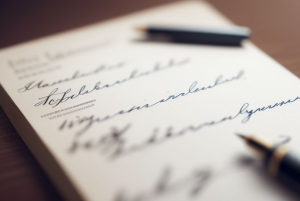By Larry Billinger
In the left corner, with the grace of a swan and the heritage of a knight, it’s the oh-so-fancy… Cursive writing! And in the right corner, armed with modern rationale and a slightly befuddled expression, it’s… everyone who’s ever owned a smartphone or computer!
The “Scribbles of the Past” Argument:
- Techie Takeover: In the age where ‘LOL’ and ‘BRB’ are considered communication, is swirling our pens around really the way to go? Can you Instagram in cursive? Didn’t think so.
- Mental Marathon: Cursive seems like that elective course at school: Bowling 101. It’s fun, but really, when will it ever come in handy for your future job?
- Read…What Now?: Let’s face it, cursive can look like someone turned worms into words. It’s like playing decipher-the-scribble every time you read a note. I can read my own cursive… Sort of! But other peoples? I can’t imagine my days teaching for Fort Hays State University having students turn in papers in cursive. It was rigorous enough typed out.
Devil’s Advocate: Cursive, The Unsung Hero?
- Brainy Benefits: Apparently, cursive is like push-ups for your brain. It’s all about the neural gains! Sure, it’s not as easy as hitting keys, but who said brain workouts were meant to be a walk in the park? So, because I know cursive, I should be smarter? Yikes!
- Historical Hoopla: Forgetting cursive is like forgetting how to read hieroglyphics—it’s a ticket to losing the golden tickets of the past. You wouldn’t want to miss out on the juicy bits of history just because you can’t decode the loops, would you?
- A Touch of Heart: A cursive letter is like a hug in an envelope. It says, “I care enough to give you cramps,” and in today’s world of emojis and gifs, that’s saying something.
- Diversity in Doodling: Having more ways to write? It’s like having more flavors of ice cream. Sure, you can live with chocolate and vanilla, but sometimes a scoop of cursive ripple can hit the spot.
Balanced Viewpoint:
In all seriousness though. While it’s understandable that some view cursive writing as a pointless endeavor in the modern world, disregarding it entirely might be overlooking its potential benefits. It is crucial to strike a balance between preserving historical and cultural heritage and advancing with the modern digital age.
A possible compromise could be to offer cursive as an optional subject, allowing students and parents to choose whether to learn it based on individual preferences and needs. This would ensure that those who see value in learning cursive can continue to do so, while others can focus on subjects they find more relevant and beneficial.
The debate over teaching cursive writing in schools hinges on its perceived relevance and utility in a rapidly evolving, technologically driven world. By considering both the critiques and the potential benefits of cursive writing, a more nuanced and balanced perspective emerges, opening the door for compromises and innovative solutions that accommodate diverse learning needs and preferences.



